The mTOR Signaling Pathway Activity and Vitamin D Availability Control the Expression of Most Autism Predisposition Genes
Abstract
1. Introduction
2. Results
2.1. SFARI Gene Database Pathway Analysis
2.2. High Scored Genes from SFARI Gene Database Network Analysis
3. Discussion
4. Materials and Methods
4.1. Extracting Genes from Diverse Data Sources
- Genes implicated in autism susceptibility (from SFARI Gene database released 01.15.2019 (Supplementary Table S1))–1053 genes;
- Genes included in the mTOR signaling network (Table S1.xlsx [51]–248 genes and KEGG database–153 genes)–341 genes;
- mTOR-sensitive genes (mTOR-sensitive 5UTR.xlsx [11])–6543 genes;
4.2. Assignment of Genes to Categories and Pathway Analysis
4.3. Network Construction
- (1)
- If the new gene interacted with one of the core genes, it was settled near this gene.
- (2)
- If the new gene interacted only with one original cluster, it was settled near this cluster.
- (3)
- If the new gene interacted with two original clusters, it was settled between them.
- (4)
- If the new gene interacted with three or more original clusters, it was settled in the middle of a network (seven rose genes).
- (5)
- Finally, the KAT2B gene that interacted with six out of seven original clusters was placed right into the center of a network.
Supplementary Materials
Author Contributions
Funding
Acknowledgments
Conflicts of Interest
Abbreviations
| ASD | autism spectrum disorder |
| SFARI | Simon’s Foundation Autism Research Initiative |
| mTOR | mechanistic target of rapamycin |
| FMRP | fragile X mental retardation protein |
Appendix A
| Categories of Genes | Total Number | Elements |
|---|---|---|
| FMRP target ∩ vitamin D-sensitive ∩ mTOR signaling pathway ∩ mTOR-modulated | 3 | PTEN APC DOCK1 |
| FMRP target ∩ mTOR signaling pathway ∩ mTOR-modulated | 6 | SYNGAP1 TSC2 CTNNB1 GSK3B EEF1A2 CUL7 |
| FMRP target ∩ vitamin D-sensitive ∩ mTOR-modulated | 17 | SYT1 SMARCC2 KDM5C DMXL2 UBE3B CLASP1 PCDH10 MAP2 HCFC1 ATP1A1 ANKRD11 SEZ6L2 RERE UPF2 LRBA MED12 NCKAP5L PCDH10 |
| FMRP target ∩ vitamin D-sensitive ∩ mTOR- pathway | 1 | DGKZ |
| Vitamin D-sensitive ∩ mTOR signaling pathway ∩ mTOR-modulated | 2 | XPO1 CCT4 |
| FMRP target ∩ mTOR-modulated | 61 | KMT2E CHD8 ARHGAP32 ATP1A3 DPYSL2 GNAS EP400 CAMTA1 AKAP9 PLXNB1 MED13 CHD3 TRIP12 DHX30 DYNC1H1 ARHGAP33 EHMT1 SLC12A5 IQSEC2 HUWE1 UBR5 BRD4 DLG4 NSD1 ATP2B2 CHD5 STXBP1 MYH10 ITPR1 CUX1 TAOK2 GRM4 ANK3 SETD5 SMARCA2 UBE3C MAGED1 KAT6A AGAP2 APP HDLBP TNRC6B NCKAP1 PHRF1 LEO1 TOP3B CHD7 EXOC6B USP7 SETDB1 SLC27A4 SND1 SETDB2 AHI1 MTR CC2D1A KIF13B SGSH GGNBP2 MCM6 ROBO1 |
| FMRP target ∩ mTOR signaling pathway | 7 | PRKCB MAPK1 PTPN11 MTOR CREBBP NF1 TAF1 |
| FMRP target ∩ vitamin D-sensitive | 40 | KCNMA1 MED13L NR2F1 WDFY3 SBF1 PACS1 SMARCA4 CAMK2A SPARCL1 KDM4B CACNA1B DLGAP3 TCF4 PDE4B CHKB SRGAP3 DLGAP1 ZNF462 TCF20 KCNQ3 DLGAP2 HIVEP3 KCND2 KIF21B DOCK4 SHANK3 NTRK3 ARID1B CUX2 DAPK1 PRICKLE2 NEO1 CCDC88C MYO9B CASK VLDLR NUP133 SSRP1 TSHZ3 NUAK1 |
| mTOR-modulated ∩ mTOR-pathway | 6 | EIF4E TSC1 CDKN1B PIK3R2 YY1 TBC1D7 |
| Vitamin D-sensitive ∩ mTOR-modulated | 49 | VDR RAB2A DLG1 ELP4 SLC33A1 STX1A MTHFR CAPRIN1 SLC16A7 CD99L2 NELL1 STAG1 LAT MEIS2 AZGP1 MPP6 ASS1 ABAT THBS1 BCAS1 DMPK ARHGAP5 OTX1 PHF8 MTF1 HDAC3 BCKDK ASTN2 SLC39A11 FGFR2 NRCAM FHIT MBD4 ETFB SLC35B1 ESR1 SIN3A SUCLG2 CSNK1D PHB PRICKLE1 MTX2 NAA15 SGSM3 HNRNPU BAIAP2 ALDH5A1 STK39 EXOC6 |
| Vitamin D-sensitive ∩ mTOR signaling pathway | 7 | CSNK1E SLC7A5 WNT2 DYRK1A DVL1 HRAS RPS6KA2 |
| Categories of Genes | Total Number | Elements |
|---|---|---|
| FMRP target ∩ vitamin D-sensitive ∩ mTOR signaling pathway ∩ mTOR-modulated | 1 | PTEN |
| FMRP target ∩ mTOR signaling pathway ∩ mTOR-modulated | 4 | SYNGAP1 CUL7 TSC2 CTNNB1 |
| FMRP target ∩ vitamin D-sensitive ∩ mTOR-modulated | 4 | SMARCC2 ANKRD11 KDM5C CLASP1 |
| Vitamin D-sensitive ∩ mTOR signaling pathway ∩ mTOR-modulated | 1 | CCT4 |
| FMRP target ∩ mTOR-modulated | 29 | EP400 USP7 UBR5 PHRF1 GGNBP2 UBE3C KMT2E CHD8 AKAP9 ATP2B2 PLXNB1 MED13 LEO1 DPYSL2 KAT6A TRIP12 DYNC1H1 STXBP1 EHMT1 MYH10 AGAP2 CUX1 TAOK2 ANK3 SETD5 SLC12A5 CC2D1A TNRC6B NCKAP1 |
| FMRP target ∩ mTOR signaling pathway | 2 | MTOR PRKCB |
| FMRP target ∩ vitamin D-sensitive | 15 | NUAK1 SMARCA4 MYO9B SHANK3 MED13L ARID1B DLGAP1 SPARCL1 TCF20 WDFY3 KCNQ3 SBF1 TCF4 PRICKLE2 HIVEP3 |
| Vitamin D-sensitive ∩ mTOR-modulated | 10 | RAB2A ELP4 PHB PRICKLE1 BCKDK NAA15 ASTN2 ETFB CAPRIN1 SLC35B1 |
| Vitamin D-sensitive ∩ mTOR signaling pathway | 2 | DYRK1A SLC7A5 |
References
- Abrahams, B.S.; Arking, D.E.; Campbell, D.B.; Mefford, H.C.; Morrow, E.M.; Weiss, L.A.; Menashe, I.; Wadkins, T.; Banerjee-Basu, S.; Packer, A. SFARI Gene 2.0: A community-driven knowledgebase for the autism spectrum disorders (ASDs). Mol. Autism 2013, 4, 36. [Google Scholar] [CrossRef] [PubMed]
- Winden, K.D.; Ebrahimi-Fakhari, D.; Sahin, M. Abnormal mTOR Activation in Autism. Annu. Rev. Neurosci. 2018, 41, 1–23. [Google Scholar] [CrossRef] [PubMed]
- Lipton, J.O.; Sahin, M. The Neurology of mTOR. Neuron 2014, 84, 275–291. [Google Scholar] [CrossRef] [PubMed]
- Lisse, T.S.; Hewison, M. Vitamin D. Cell Cycle 2011, 10, 1888–1889. [Google Scholar] [CrossRef] [PubMed]
- Liu, Y.; Zhang, D.; Liu, X. mTOR Signaling in T Cell Immunity and Autoimmunity. Int. Rev. Immunol. 2015, 34, 50–66. [Google Scholar] [CrossRef] [PubMed]
- Zhou, J.; Parada, L.F. PTEN signaling in autism spectrum disorders. Curr. Opin. Neurobiol. 2012, 22, 873–879. [Google Scholar] [CrossRef] [PubMed]
- Bockaert, J.; Marin, P. mTOR in Brain Physiology and Pathologies. Physiol. Rev. 2015, 95, 1157–1187. [Google Scholar] [CrossRef]
- Onore, C.; Yang, H.; Van de Water, J.; Ashwood, P. Dynamic Akt/mTOR Signaling in Children with Autism Spectrum Disorder. Front. Pediatr. 2017, 5, 43. [Google Scholar] [CrossRef]
- Tylee, D.S.; Hess, J.L.; Quinn, T.P.; Barve, R.; Huang, H.; Zhang-James, Y.; Chang, J.; Stamova, B.S.; Sharp, F.R.; Hertz-Picciotto, I.; et al. Blood transcriptomic comparison of individuals with and without autism spectrum disorder: A combined-samples mega-analysis. Am. J. Med. Genet. Part B Neuropsychiatr. Genet. 2017, 174, 181–201. [Google Scholar] [CrossRef]
- Masvidal, L.; Hulea, L.; Furic, L.; Topisirovic, I.; Larsson, O. mTOR-sensitive translation: Cleared fog reveals more trees. RNA Biol. 2017, 14, 1299–1305. [Google Scholar] [CrossRef]
- Gandin, V.; Masvidal, L.; Hulea, L.; Gravel, S.-P.; Cargnello, M.; McLaughlan, S.; Cai, Y.; Balanathan, P.; Morita, M.; Rajakumar, A.; et al. nanoCAGE reveals 5′ UTR features that define specific modes of translation of functionally related MTOR-sensitive mRNAs. Genome Res. 2016, 26, 636–648. [Google Scholar] [CrossRef] [PubMed]
- Jansen, A.; Dieleman, G.C.; Smit, A.B.; Verhage, M.; Verhulst, F.C.; Polderman, T.J.C.; Posthuma, D. Gene-set analysis shows association between FMRP targets and autism spectrum disorder. Eur. J. Hum. Genet. 2017, 25, 863–868. [Google Scholar] [CrossRef] [PubMed]
- Narayanan, U.; Nalavadi, V.; Nakamoto, M.; Thomas, G.; Ceman, S.; Bassell, G.J.; Warren, S.T. S6K1 Phosphorylates and Regulates Fragile X Mental Retardation Protein (FMRP) with the Neuronal Protein Synthesis-dependent Mammalian Target of Rapamycin (mTOR) Signaling Cascade. J. Biol. Chem. 2008, 283, 18478–18482. [Google Scholar] [CrossRef] [PubMed]
- Patrick, R.P.; Ames, B.N. Vitamin D hormone regulates serotonin synthesis. Part 1: Relevance for autism. FASEB J. 2014, 28, 2398–2413. [Google Scholar] [CrossRef] [PubMed]
- Wang, T.-T.; Tavera-Mendoza, L.E.; Laperriere, D.; Libby, E.; Burton MacLeod, N.; Nagai, Y.; Bourdeau, V.; Konstorum, A.; Lallemant, B.; Zhang, R.; et al. Large-Scale in Silico and Microarray-Based Identification of Direct 1,25-Dihydroxyvitamin D3 Target Genes. Mol. Endocrinol. 2005, 19, 2685–2695. [Google Scholar] [CrossRef]
- McCann, J.C.; Ames, B.N. Is there convincing biological or behavioral evidence linking vitamin D deficiency to brain dysfunction? FASEB J. 2008, 22, 982–1001. [Google Scholar] [CrossRef]
- Sawatsubashi, S.; Nishimura, K.; Mori, J.; Kouzmenko, A.; Kato, S. The Function of the Vitamin D Receptor and a Possible Role of Enhancer RNA in Epigenomic Regulation of Target Genes: Implications for Bone Metabolism. J. Bone Metab. 2019, 26, 3. [Google Scholar] [CrossRef]
- Lisse, T.S.; Liu, T.; Irmler, M.; Beckers, J.; Chen, H.; Adams, J.S.; Hewison, M. Gene targeting by the vitamin D response element binding protein reveals a role for vitamin D in osteoblast mTOR signaling. FASEB J. 2011, 25, 937–947. [Google Scholar] [CrossRef]
- Szklarczyk, D.; Gable, A.L.; Lyon, D.; Junge, A.; Wyder, S.; Huerta-Cepas, J.; Simonovic, M.; Doncheva, N.T.; Morris, J.H.; Bork, P.; et al. von STRING v11: Protein–protein association networks with increased coverage, supporting functional discovery in genome-wide experimental datasets. Nucleic Acids Res. 2019, 47, D607–D613. [Google Scholar] [CrossRef]
- Shannon, P.; Markiel, A.; Ozier, O.; Baliga, N.S.; Wang, J.T.; Ramage, D.; Amin, N.; Schwikowski, B.; Ideker, T. Cytoscape: A software Environment for integrated models of biomolecular interaction networks. Genome Res. 2003, 13, 2498–2504. [Google Scholar] [CrossRef]
- Su, G.; Morris, J.H.; Demchak, B.; Bader, G.D. Biological Network Exploration with Cytoscape 3. Curr. Protoc. Bioinform. 2014, 47, 8–13. [Google Scholar] [CrossRef] [PubMed]
- Smoot, M.E.; Ono, K.; Ruscheinski, J.; Wang, P.-L.; Ideker, T. Cytoscape 2.8: New features for data integration and network visualization. Bioinformatics 2011, 27, 431–432. [Google Scholar] [CrossRef] [PubMed]
- Peters, S.U.; Horowitz, L.; Barbieri-Welge, R.; Taylor, J.L.; Hundley, R.J. Longitudinal follow-up of autism spectrum features and sensory behaviors in Angelman syndrome by deletion class. J. Child Psychol. Psychiatry 2012, 53, 152–159. [Google Scholar] [CrossRef] [PubMed]
- Sun, J.; Liu, Y.; Moreno, S.; Baudry, M.; Bi, X. Imbalanced Mechanistic Target of Rapamycin C1 and C2 Activity in the Cerebellum of Angelman Syndrome Mice Impairs Motor Function. J. Neurosci. 2015, 35, 4706–4718. [Google Scholar] [CrossRef] [PubMed]
- Shi, L. Dock protein family in brain development and neurological disease. Commun. Integr. Biol. 2013, 6, e26839. [Google Scholar] [CrossRef] [PubMed]
- Mohn, J.L.; Alexander, J.; Pirone, A.; Palka, C.D.; Lee, S.-Y.; Mebane, L.; Haydon, P.G.; Jacob, M.H. Adenomatous polyposis coli protein deletion leads to cognitive and autism-like disabilities. Mol. Psychiatry 2014, 19, 1133–1142. [Google Scholar] [CrossRef]
- Xiong, Q.; Oviedo, H.V.; Trotman, L.C.; Zador, A.M. PTEN Regulation of Local and Long-Range Connections in Mouse Auditory Cortex. J. Neurosci. 2012, 32, 1643–1652. [Google Scholar] [CrossRef]
- Khlebodarova, T.M.; Kogai, V.V.; Trifonova, E.A.; Likhoshvai, V.A. Dynamic landscape of the local translation at activated synapses. Mol. Psychiatry 2018, 23, 107–114. [Google Scholar] [CrossRef]
- Berridge, M.J. Vitamin D cell signalling in health and disease. Biochem. Biophys. Res. Commun. 2015, 460, 53–71. [Google Scholar] [CrossRef]
- Gutknecht, L.; Kriegebaum, C.; Waider, J.; Schmitt, A.; Lesch, K.-P. Spatio-temporal expression of tryptophan hydroxylase isoforms in murine and human brain: Convergent data from Tph2 knockout mice. Eur. Neuropsychopharmacol. 2009, 19, 266–282. [Google Scholar] [CrossRef]
- Shariev, A.; Painter, N.; Mason, R.; Dixon, K. PTEN: A novel target for vitamin D in the fight against melanoma. In Proceedings of the 16th World Congress on Cancers of the Skin, Vienna, Austria, 31 August–3 September 2016; Volume 26. [Google Scholar] [CrossRef]
- Vinkhuyzen, A.A.E.; Eyles, D.W.; Burne, T.H.J.; Blanken, L.M.E.; Kruithof, C.J.; Verhulst, F.; White, T.; Jaddoe, V.W.; Tiemeier, H.; McGrath, J.J. Gestational vitamin D deficiency and autism spectrum disorder. BJPsych Open 2017, 3, 85–90. [Google Scholar] [CrossRef] [PubMed]
- Vinkhuyzen, A.A.E.; Eyles, D.W.; Burne, T.H.J.; Blanken, L.M.E.; Kruithof, C.J.; Verhulst, F.; Jaddoe, V.W.; Tiemeier, H.; McGrath, J.J. Gestational vitamin D deficiency and autism-related traits: The Generation R Study. Mol. Psychiatry 2018, 23, 240–246. [Google Scholar] [CrossRef] [PubMed]
- Lee, B.K.; Eyles, D.W.; Magnusson, C.; Newschaffer, C.J.; McGrath, J.J.; Kvaskoff, D.; Ko, P.; Dalman, C.; Karlsson, H.; Gardner, R.M. Developmental vitamin D and autism spectrum disorders: Findings from the Stockholm Youth Cohort. Mol. Psychiatry 2019. [Google Scholar] [CrossRef] [PubMed]
- Wu, D.-M.; Wen, X.; Han, X.-R.; Wang, S.; Wang, Y.-J.; Shen, M.; Fan, S.-H.; Zhuang, J.; Li, M.-Q.; Hu, B.; et al. Relationship Between Neonatal Vitamin D at Birth and Risk of Autism Spectrum Disorders: The NBSIB Study. J. Bone Min. Res. 2018, 33, 458–466. [Google Scholar] [CrossRef]
- Ehninger, D.; Sano, Y.; de Vries, P.J.; Dies, K.; Franz, D.; Geschwind, D.H.; Kaur, M.; Lee, Y.-S.; Li, W.; Lowe, J.K.; et al. Gestational immune activation and Tsc2 haploinsufficiency cooperate to disrupt fetal survival and may perturb social behavior in adult mice. Mol. Psychiatry 2012, 17, 62–70. [Google Scholar] [CrossRef]
- Lombardo, M.V.; Moon, H.M.; Su, J.; Palmer, T.D.; Courchesne, E.; Pramparo, T. Maternal immune activation dysregulation of the fetal brain transcriptome and relevance to the pathophysiology of autism spectrum disorder. Mol. Psychiatry 2018, 23, 1001–1013. [Google Scholar] [CrossRef]
- Brandler, W.M.; Antaki, D.; Gujral, M.; Kleiber, M.L.; Whitney, J.; Maile, M.S.; Hong, O.; Chapman, T.R.; Tan, S.; Tandon, P.; et al. Paternally inherited cis-regulatory structural variants are associated with autism. Science 2018, 360, 327–331. [Google Scholar] [CrossRef]
- Liu, M.; Wilk, S.A.; Wang, A.; Zhou, L.; Wang, R.-H.; Ogawa, W.; Deng, C.; Dong, L.Q.; Liu, F. Resveratrol Inhibits mTOR Signaling by Promoting the Interaction between mTOR and DEPTOR. J. Biol. Chem. 2010, 285, 36387–36394. [Google Scholar] [CrossRef]
- Bhandari, R.; Kuhad, A. Resveratrol suppresses neuroinflammation in the experimental paradigm of autism spectrum disorders. Neurochem. Int. 2017, 103, 8–23. [Google Scholar] [CrossRef]
- Jia, F.; Wang, B.; Shan, L.; Xu, Z.; Staal, W.G.; Du, L. Core Symptoms of Autism Improved After Vitamin D Supplementation. Pediatrics 2015, 135, e196–e198. [Google Scholar] [CrossRef]
- Jia, F.; Shan, L.; Wang, B.; Li, H.; Feng, J.; Xu, Z.; Saad, K. Fluctuations in clinical symptoms with changes in serum 25(OH) vitamin D levels in autistic children: Three cases report. Nutr. Neurosci. 2019, 22, 863–866. [Google Scholar] [CrossRef] [PubMed]
- Mazahery, H.; Conlon, C.A.; Beck, K.L.; Mugridge, O.; Kruger, M.C.; Stonehouse, W.; Camargo, C.A.; Meyer, B.J.; Tsang, B.; Jones, B.; et al. A Randomised-Controlled Trial of Vitamin D and Omega-3 Long Chain Polyunsaturated Fatty Acids in the Treatment of Core Symptoms of Autism Spectrum Disorder in Children. J. Autism Dev. Disord. 2019, 49, 1778–1794. [Google Scholar] [CrossRef] [PubMed]
- Carbon, M.; Kapoor, S.; Sheridan, E.; Al-Jadiri, A.; Azzo, S.; Sarkaria, T.; Kane, J.M.; Saito, E.; Correll, C.U. Neuromotor Adverse Effects in 342 Youth During 12 Weeks of Naturalistic Treatment with 5 Second-Generation Antipsychotics. J. Am. Acad. Child Adolesc. Psychiatry 2015, 54, 718–727. [Google Scholar] [CrossRef] [PubMed]
- Mas, S.; Gassó, P.; Boloc, D.; Rodriguez, N.; Mármol, F.; Sánchez, J.; Bernardo, M.; Lafuente, A. Network analysis of gene expression in mice provides new evidence of involvement of the mTOR pathway in antipsychotic-induced extrapyramidal symptoms. Pharm. J. 2016, 16, 293–300. [Google Scholar] [CrossRef]
- Kochetov, A.V.; Allmer, J.; Klimenko, A.I.; Zuraev, B.S.; Matushkin, Y.G.; Lashin, S.A. AltORFev facilitates the prediction of alternative open reading frames in eukaryotic mRNAs. Bioinformatics 2016, 33, 923–925. [Google Scholar] [CrossRef]
- Kochetov, A.V.; Prayaga, P.D.; Volkova, O.A.; Sankararamakrishnan, R. Hidden coding potential of eukaryotic genomes: NonAUG started ORFs. J. Biomol. Struct. Dyn. 2013, 31, 103–114. [Google Scholar] [CrossRef]
- Ventoso, I.; Kochetov, A.; Montaner, D.; Dopazo, J.; Santoyo, J. Extensive Translatome Remodeling during ER Stress Response in Mammalian Cells. PLoS ONE 2012, 7, e35915. [Google Scholar] [CrossRef]
- Kanehisa, M.; Furumichi, M.; Tanabe, M.; Sato, Y.; Morishima, K. KEGG: New perspectives on genomes, pathways, diseases and drugs. Nucleic Acids Res. 2017, 45, D353–D361. [Google Scholar] [CrossRef]
- Darnell, J.C.; Van Driesche, S.J.; Zhang, C.; Hung, K.Y.S.; Mele, A.; Fraser, C.E.; Stone, E.F.; Chen, C.; Fak, J.J.; Chi, S.W.; et al. FMRP Stalls Ribosomal Translocation on mRNAs Linked to Synaptic Function and Autism. Cell 2011, 146, 247–261. [Google Scholar] [CrossRef]
- Caron, E.; Ghosh, S.; Matsuoka, Y.; Ashton-Beaucage, D.; Therrien, M.; Lemieux, S.; Perreault, C.; Roux, P.P.; Kitano, H. A comprehensive map of the mTOR signaling network. Mol. Syst. Biol. 2010, 6, 453. [Google Scholar] [CrossRef]
- Desai, M.S.; Seekatz, A.M.; Koropatkin, N.M.; Kamada, N.; Hickey, C.A.; Wolter, M.; Pudlo, N.A.; Kitamoto, S.; Terrapon, N.; Muller, A.; et al. A Dietary Fiber-Deprived Gut Microbiota Degrades the Colonic Mucus Barrier and Enhances Pathogen Susceptibility. Cell 2016, 167, 1339–1353. [Google Scholar] [CrossRef] [PubMed]
- Sharon, G.; Cruz, N.J.; Kang, D.-W.; Gandal, M.J.; Wang, B.; Kim, Y.-M.; Zink, E.M.; Casey, C.P.; Taylor, B.C.; Lane, C.J.; et al. Human Gut Microbiota from Autism Spectrum Disorder Promote Behavioral Symptoms in Mice. Cell 2019, 177, 1600–1618. [Google Scholar] [CrossRef] [PubMed]
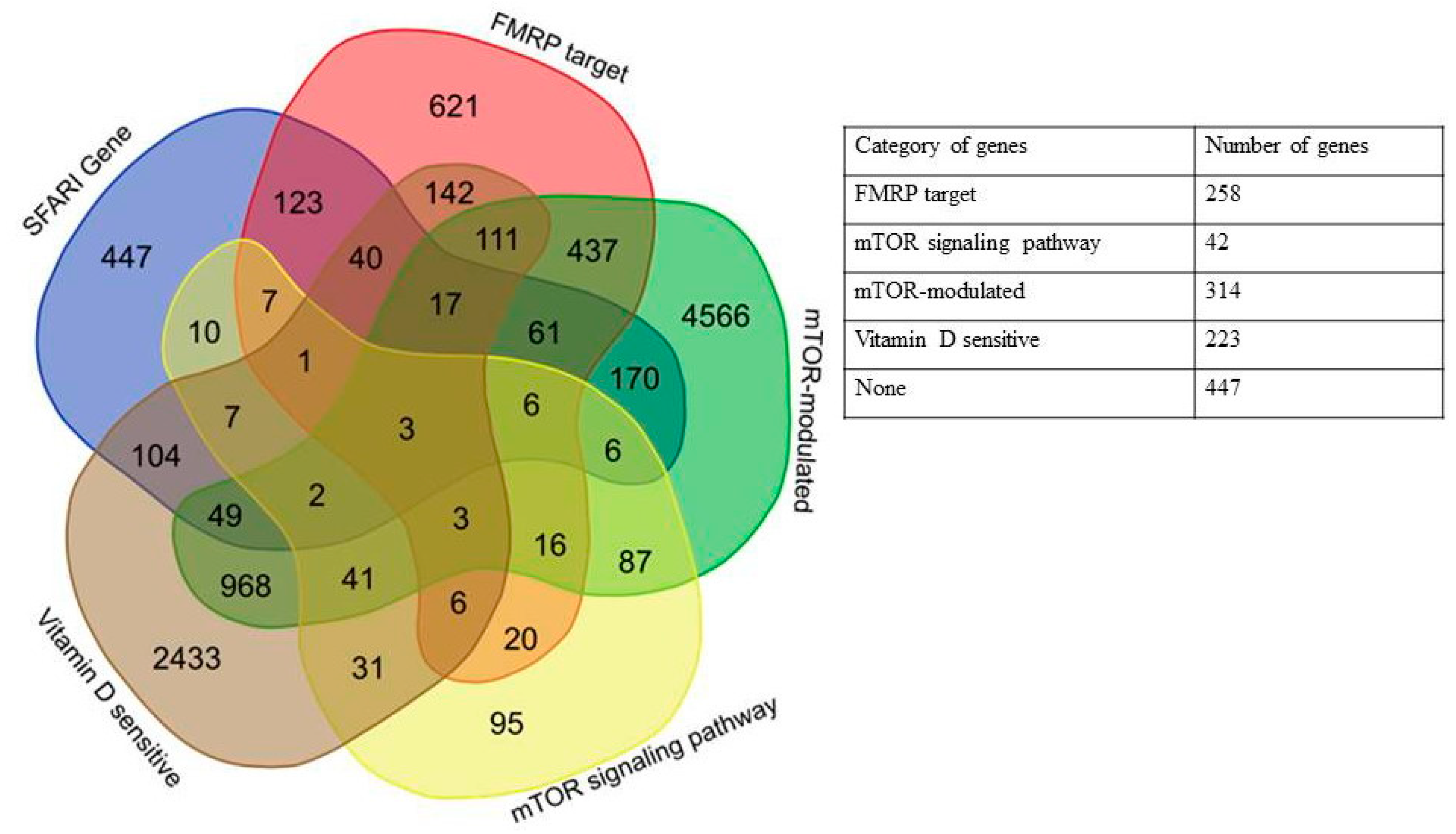
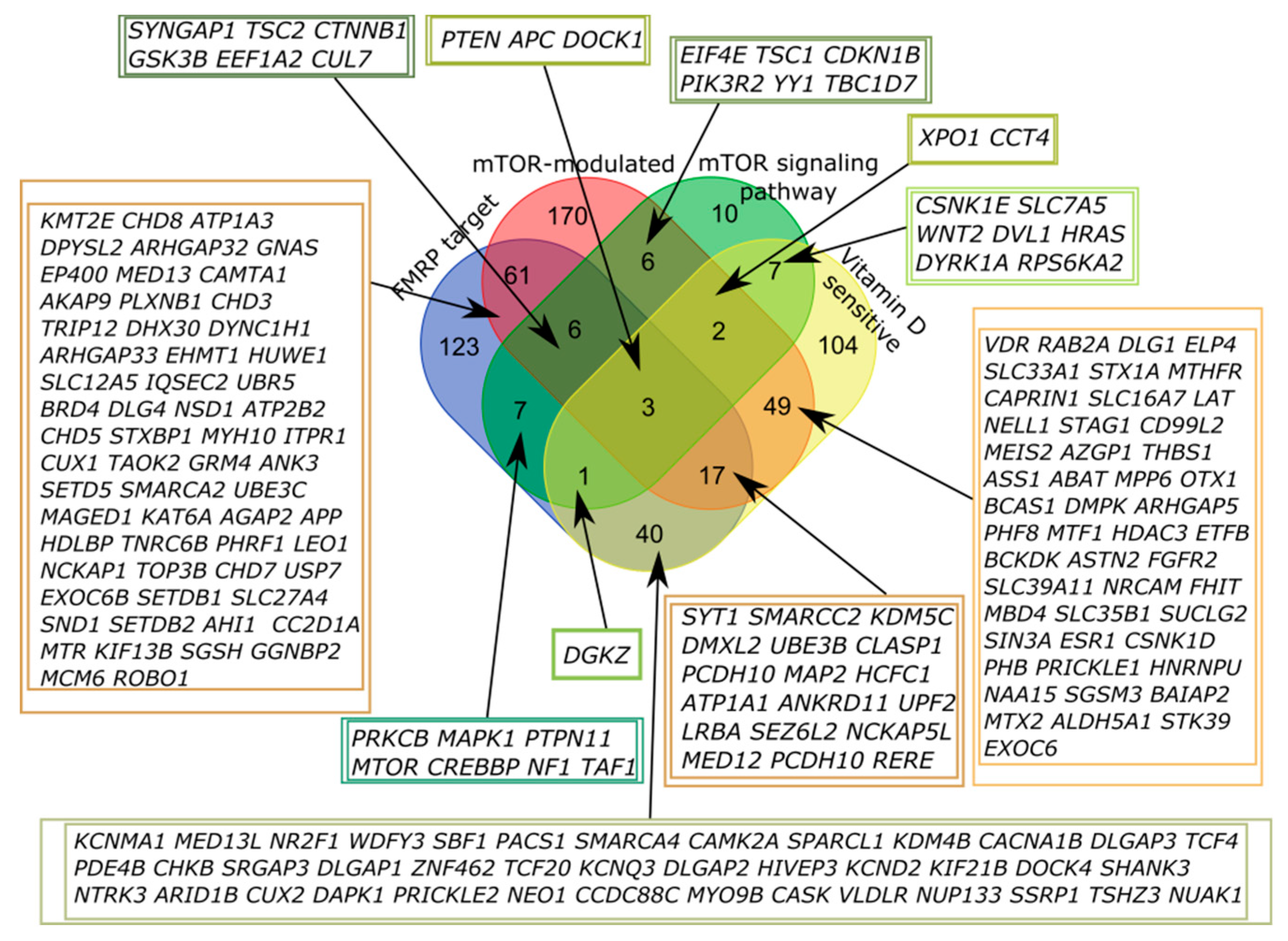
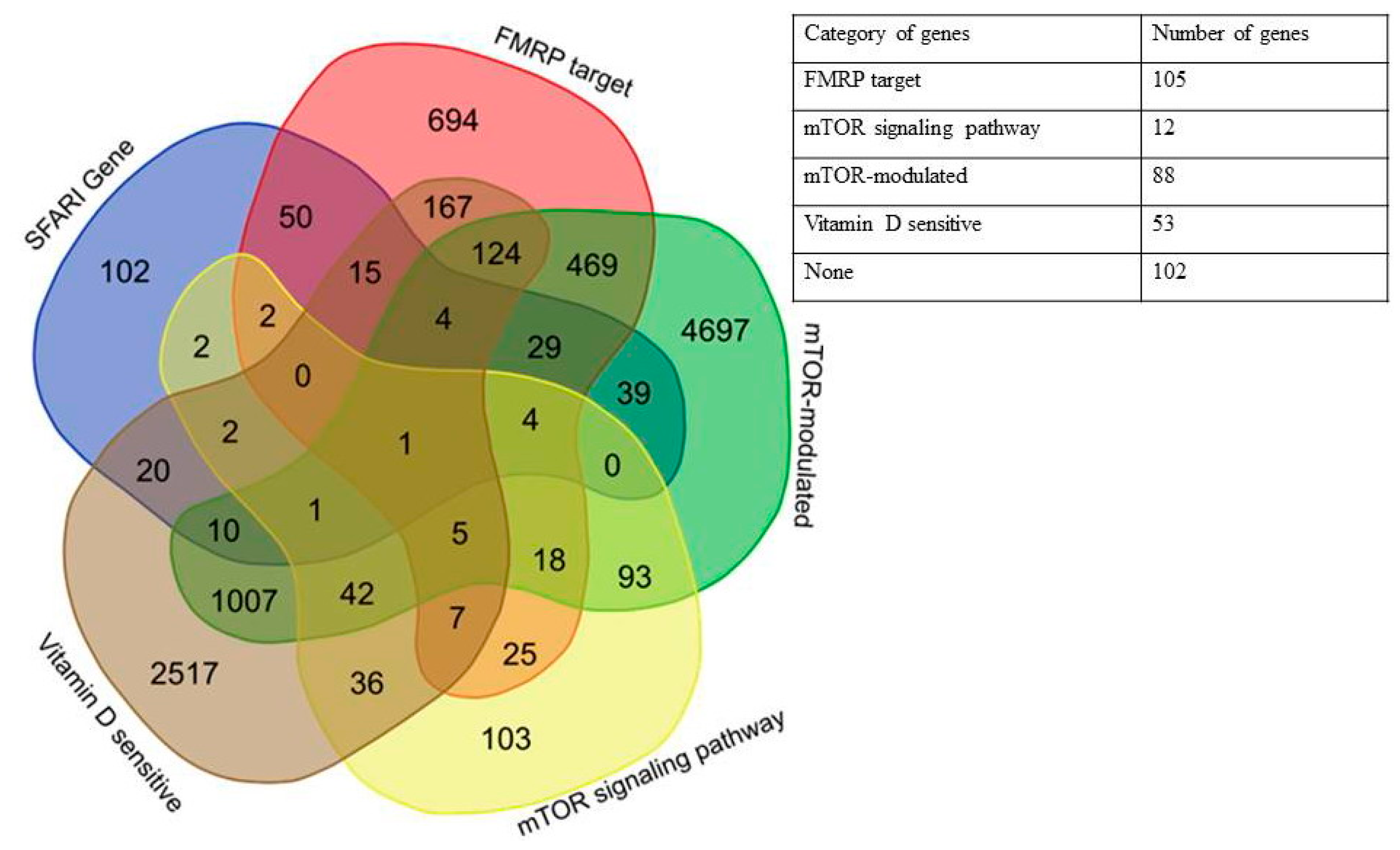
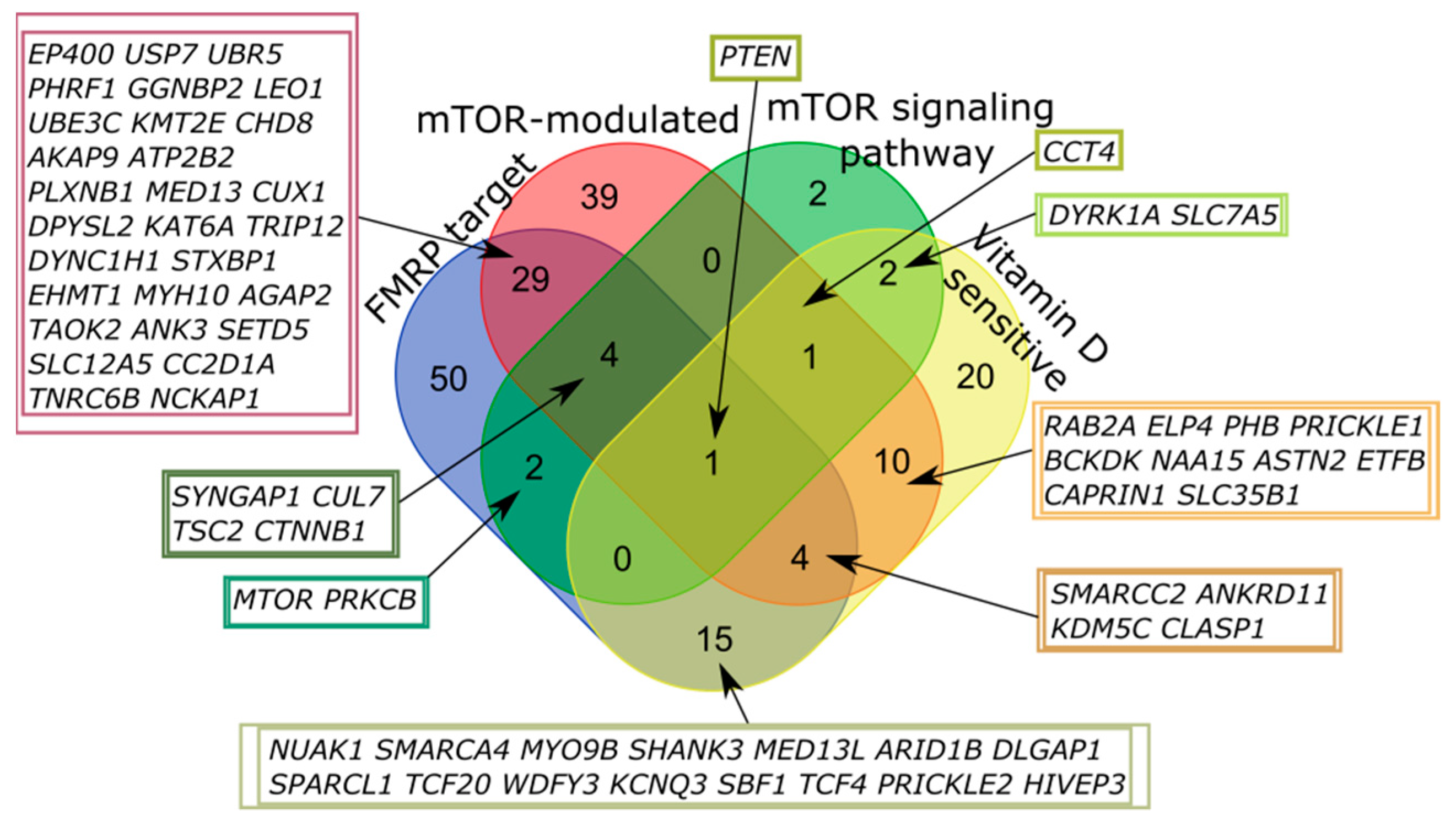
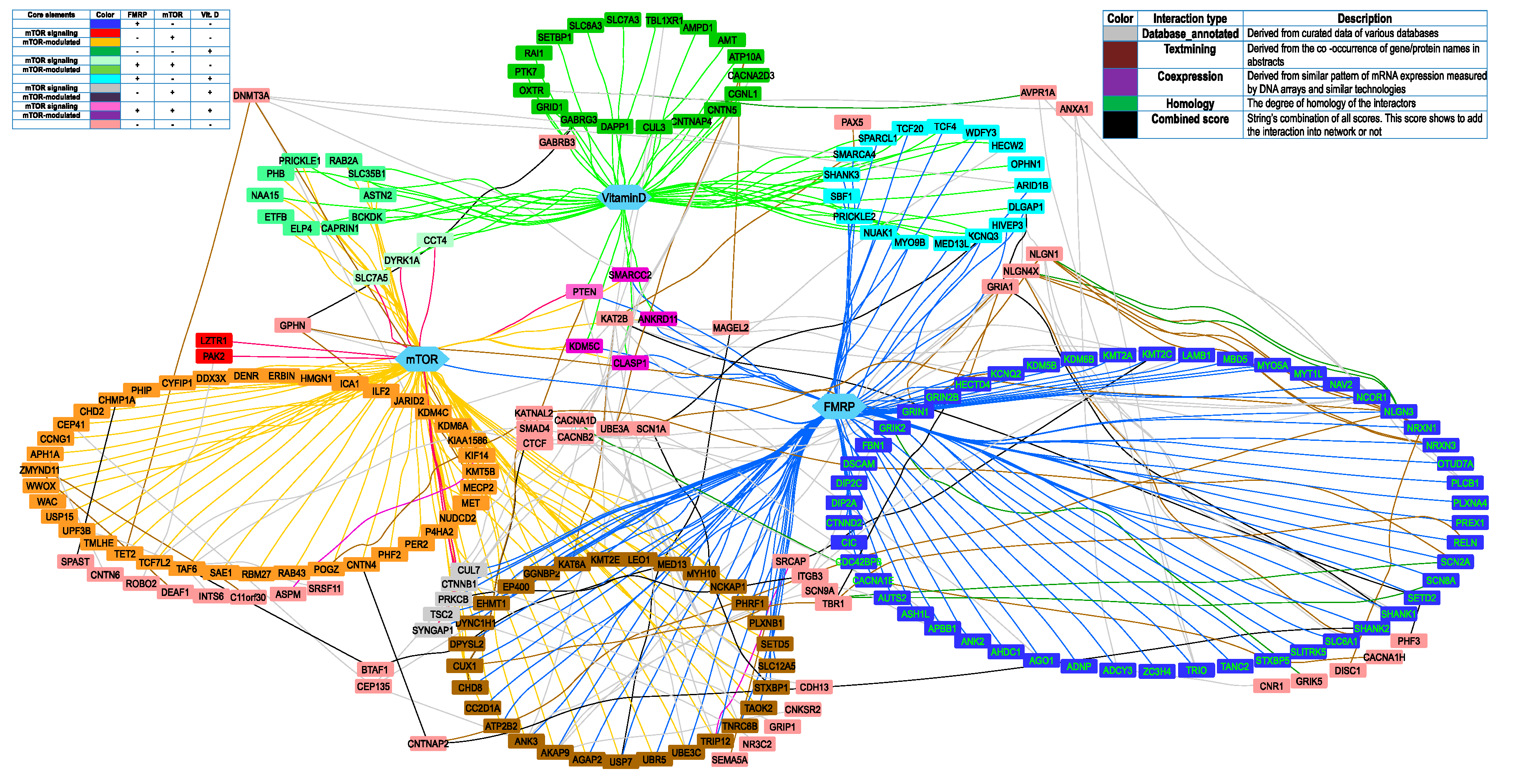
© 2019 by the authors. Licensee MDPI, Basel, Switzerland. This article is an open access article distributed under the terms and conditions of the Creative Commons Attribution (CC BY) license (http://creativecommons.org/licenses/by/4.0/).
Share and Cite
Trifonova, E.A.; Klimenko, A.I.; Mustafin, Z.S.; Lashin, S.A.; Kochetov, A.V. The mTOR Signaling Pathway Activity and Vitamin D Availability Control the Expression of Most Autism Predisposition Genes. Int. J. Mol. Sci. 2019, 20, 6332. https://doi.org/10.3390/ijms20246332
Trifonova EA, Klimenko AI, Mustafin ZS, Lashin SA, Kochetov AV. The mTOR Signaling Pathway Activity and Vitamin D Availability Control the Expression of Most Autism Predisposition Genes. International Journal of Molecular Sciences. 2019; 20(24):6332. https://doi.org/10.3390/ijms20246332
Chicago/Turabian StyleTrifonova, Ekaterina A., Alexandra I. Klimenko, Zakhar S. Mustafin, Sergey A. Lashin, and Alex V. Kochetov. 2019. "The mTOR Signaling Pathway Activity and Vitamin D Availability Control the Expression of Most Autism Predisposition Genes" International Journal of Molecular Sciences 20, no. 24: 6332. https://doi.org/10.3390/ijms20246332
APA StyleTrifonova, E. A., Klimenko, A. I., Mustafin, Z. S., Lashin, S. A., & Kochetov, A. V. (2019). The mTOR Signaling Pathway Activity and Vitamin D Availability Control the Expression of Most Autism Predisposition Genes. International Journal of Molecular Sciences, 20(24), 6332. https://doi.org/10.3390/ijms20246332






